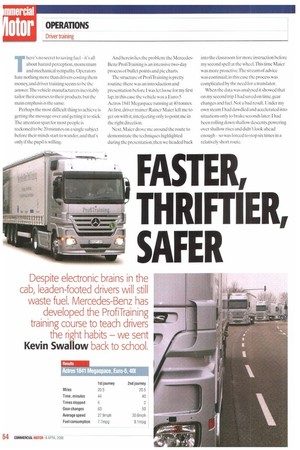FASTER, THRIFTIER, SAFER
Page 66

If you've noticed an error in this article please click here to report it so we can fix it.
Despite electronic brains in the cab, leaden-footed drivers will still waste fuel. Mercedes-Benz has developed the ProfiTraining training course to teach drivers
the right habits — we sent Fit
Kevin Swallow back to school.
There's no secret to saving fuel — it's all about hazard perception, momentum and mechanical sympathy. Operators hate nothing more than drivers costing them money, and driver training seems to be the answer. The vehicle manufacturers inevitably tailor their courses to their products. but the main emphasis is the same.
Perhaps the most difficult thing to achieve is getting the message over and getting it to stick. The attention span for most people is reckoned lobe 20 minutes on a single subject before their minds start to wander, and that's only if the pupil is willing. And herein lies the problem: the MercedesBenz ProfiTraining is an intensive two-day process of bullet points and pie charts.
The structure of ProfiTraining is pretty routine: there was an introduction and presentation before I was let loose for my first lap; in this case the vehicle was a Euro-5 Actros 1841 Megaspace running at 40 tonnes. At first, driver trainer Rainer Maier left me to get on with it, interjecting only to point me in the right direction.
Next, Maier drove me around the route to demonstrate the techniques highlighted during the presentation; then we headed back into the classroom for more instruction before my second spell at the wheel.This time Maier was more proactive. Th e stream of advice was continual; in this case the process was complicated by the need for a translator.
When the data was analysed it showed that on my second trip I had saved on time, gear changes and fuel.Not a had result. Under my own steam I had dawdled and accelerated into situations only to brake seconds later.1 had been rolling down shallow descents, powering over shallow rises and didn't look ahead enough —so was forced to stop six times in a relatively short route.
































































































































































































